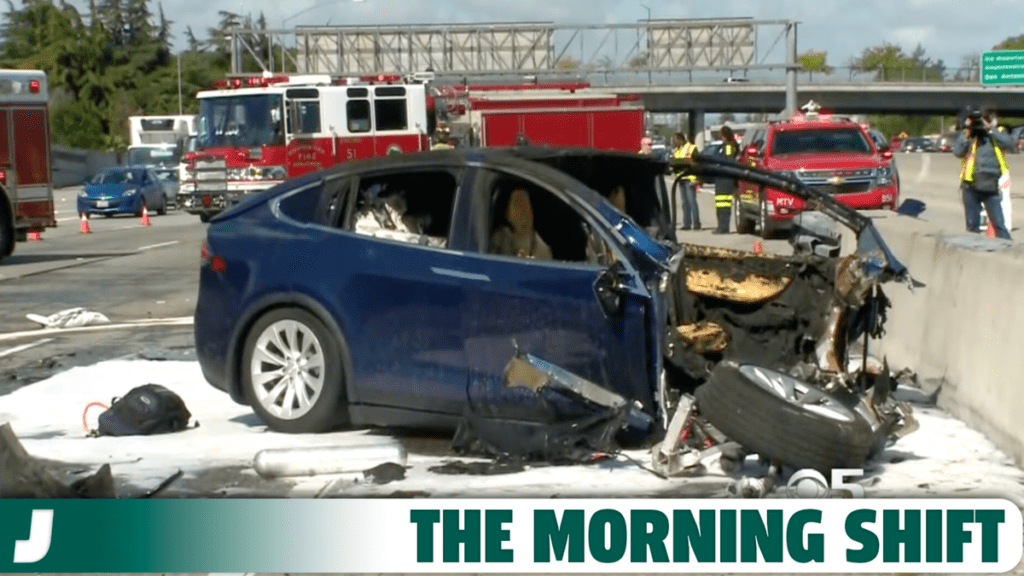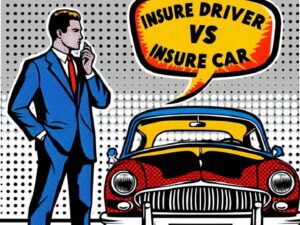Tesla Settles Fatal Autopilot Crash Lawsuit Hours Before Trial Set To Start

Good morning! It’s Tuesday, April 9, 2024, and this is The Morning Shift, your daily roundup of the top automotive headlines from around the world, in one place. Here are the important stories you need to know.
Tesla’s Cybertruck Has Finally Arrived
1st Gear: Tesla Settle Autopilot Suit On Eve Of Trial
Tesla reached a settlement with the family of a killed Apple engineer on the evening before its highest-profile Autopilot crash trial was set to take place. Terms of the settlement were not disclosed in court filings made in state court in San Jose, California on April 8. From Bloomberg:
The case centered on Walter Huang, a 38-year-old Apple Inc. engineer who was killed on the way to work in 2018 when his Model X veered off the highway and slammed into a roadside barrier at about 71 miles (114 kilometers) per hour. The National Transportation Safety Board’s investigation found that Huang probably was distracted by a video game app on his iPhone, while also pointing to “limitations” with the Autopilot system.
The electric-vehicle maker prevailed in two previous trials in California after juries found the accidents — one fatal and one not — were due to driver error rather than the company’s technology. Each of the trials, and more that are scheduled in coming months in California and Florida, clash with Musk’s mantra that Teslas are the safest cars ever made.
“This is an important data point,” said Bryant Walker Smith, a University of South Carolina law professor and automated-driving expert. “It doesn’t guarantee future outcomes but it does tell the story of a company that is not publicly invincible.”
He said it’s not unusual for cases to be resolved on the eve of trial, but it is surprising that Tesla settled this one.
“At this point everybody already had their script — it’s just kind of doing the math,” he said. “I suspect each side looked at their chances and Tesla decided that publicly settling was preferable to possibly losing in court.”
The trial would have included testimony from both current and former Tesla engineers.
The Austin, Texas-based automaker is facing increased regulatory scrutiny over both its Autopilot and Full Self-Driving driver assist programs. At the tail end of last year, Tesla recalled and performed over-the-air updates on over two million vehicles after the National Highway Traffic Safety Administration said Autopilot didn’t do enough to stop people from misusing it.
Tesla’s website describes Autopilot as “an advanced driver-assistance system that enhances safety and convenience behind the wheel.” The company says that Autopilot enables its vehicles to steer, accelerate and brake automatically, but that the system’s features require “active driver supervision and do not make the vehicle autonomous.”
Musk, Tesla’s chief executive officer, has always taken an aggressive approach to litigation. In May 2022, he announced that Tesla was building a “hardcore litigation department” that would initiate and execute lawsuits. The Austin-based company has a long history of going to great lengths to defend itself in court.
Beyond their claims against Tesla, the Huangs also alleged that California’s transportation department was partly to blame for failing to fix the barrier that had recently sustained damage from another crash. Had it been repaired, they said, it might have absorbed the impact of the Model X collision and saved Walter Huang’s life.
In 2022, Musk posted on Twitter, saying Tesla would never “surrender/settle an unjust case against us.” It seems that his tune has changed just a bit with this latest settlement.
2nd Gear: Vehicle Imports Pile Up At European Ports
Imported vehicles are seriously piling up at European ports, turning them into “car parks.” Automakers are distributors are struggling with a slowdown in car sales as well as logistical bottlenecks that make it hard to alleviate the buildup of new, unsold vehicles. From the Financial Times:
Port and car industry executives have pointed to a pile-up of Chinese electric cars as one of the leading causes of the problem, with some companies booking shipping delivery slots without ordering onward transportation. In other instances, carmakers in general are struggling to order trucks because of the lack of drivers and equipment to move the vehicles on.
“Car distributors are increasingly using the port’s car parks as a depot. Instead of stocking the cars at the dealers, they are collected at the car terminal,” said the Port of Antwerp-Bruges, whose port at Zeebrugge is Europe’s busiest port for car imports. “All major car ports” were struggling with congestion, the port added, without specifying the origin of the vehicles.
Some car industry executives said Chinese carmakers were not selling their vehicles in Europe as fast as they expected, which was a major contributor to the glut at the region’s ports.
“Chinese EV makers are using ports like car parks,” said one car supply chain manager.
Some Chinese brand EVs had been sitting in European ports for up to 18 months, while some ports had asked importers to provide proof of onward transport, according to industry executives. One car logistics expert said many of the unloaded vehicles were simply staying in the ports until they were sold to distributors or end users.
“It’s chaos,” said another person who had been briefed on the situation.
Cui Dongshu, the secretary-general of the China Passenger Car Association, told FT that inland shipping into European markets is proving difficult for Chinese EV makers.
Emphasising that brands needed to improve their “after sale” services, he added: “[We need to] change the guerrilla warlike car exports, which will throw ourselves into an unfavourable situation.”
BLG Logistics, the company that operates the car-handling terminal at the German port of Bremerhaven, Europe’s second-busiest port for vehicles, said it had experienced longer dwell times at its facilities after Germany’s federal government stopped subsidising purchases of EVs in December last year.
The clogging up of car terminals comes as many of China’s carmakers, such as BYD, Great Wall, Chery and SAIC, are planning an export push to Europe, both to keep their factories in China running and to capitalise on the region’s appetite for electric cars.
Emphasising that brands needed to improve their “after sale” services, he added: “[We need to] change the guerrilla warlike car exports, which will throw ourselves into an unfavourable situation.”
BLG Logistics, the company that operates the car-handling terminal at the German port of Bremerhaven, Europe’s second-busiest port for vehicles, said it had experienced longer dwell times at its facilities after Germany’s federal government stopped subsidising purchases of EVs in December last year.
The clogging up of car terminals comes as many of China’s carmakers, such as BYD, Great Wall, Chery and SAIC, are planning an export push to Europe, both to keep their factories in China running and to capitalise on the region’s appetite for electric cars.
Many Chinese automakers are reportedly building teams in Europe from scratch and dealing with real-world logistical challenges. They’ve also struggled to find haulage companies to prioritize their vehicles since they’re newcomers to the market. One person told the outlet that a “lack of trucks” is a “very common problem.”
3rd Gear: A New Small Acura Crossover Is Coming
Acura unveiled the name of its new subcompact crossover: the ADX. It’s set to launch later this year, and it’ll be the fourth crossover in the Japanese automaker’s lineup, slotting right below the compact RDX.
This is apparently a long time coming for Acura and its dealers. From Automotive News:
Brian Benstock, chairman of the Acura National Dealer Advisory Board, told Automotive News that dealers have been hoping for a smaller crossover.
“It’s about time,” Benstock said. “It’s a great segment, and we think it’s a growing segment. It’ll really add to our ability to add significant volume to the brand.”
This year, American Honda said it would add an entry-level, gasoline-powered crossover to Acura’s U.S. lineup in 2024 but did not provide details other than size.
Benstock said Acura did not indicate whether it had plans to evolve the ADX into an electric vehicle.
“They are keeping their cards close to their chest when it comes to that, but everything’s going to turn into an EV eventually. And we’re looking forward to that,” he said.
In more Acura news, the automaker reportedly hinted that an electric version of its three-row midsize MDX crossover could be coming down the line, but it didn’t say when.
Listen, as long as these cars aren’t just General Motors products with an Acura badge glued onto the steering wheel, I’ll be fine with them.
4th Gear: GM’s Cruise Robotaxis Returns To Phoenix
General Motor’s much beleagerd Cruise robotaxi business is getting ready to resume testing with safety drivers in Phoenix, Arizona. It’s a big step in the automaker’s attempts to resume service after its fleet was grounded in 2023. From Bloomberg:
The company is set to announce and begin the testing as early as Tuesday, according to two people with knowledge of the matter. In recent months, Cruise has been in talks with officials in 20 metropolitan areas where it previously ran cars or had started mapping in preparation to run them. Phoenix is a natural place to start as Cruise already has vehicles in the area and city officials were open to the idea of its return, said one of the people, who asked not to be named as the plan isn’t public.
Cruise spokesman Pat Morrissey said in an email that the company “had not set a timeline for deployment. We are in the process of meeting with officials in select markets to gather information, share updates and rebuild trust.”
Getting Cruise back on the road is important for GM Chief Executive Officer Mary Barra, who has pledged to take the carmaker to leadership in electric vehicles and self-driving technology during her tenure. The robotaxi business was supposed to be a key part of her goal to double revenue to $280 billion by 2030. With Cruise’s problems and a slowdown in EV sales growth, that target looks tougher to reach.
The robotaxi company has been working to earn the public’s confidence after one of its cars struck and dragged a pedestrian in San Francisco in October. Following the incident, California regulators alleged that Cruise initially withheld key footage and details of the incident, which ultimately resulted in the suspension of Cruise’s license in California.
After that, Cruise suspended all operations nationwide, took the resignation of founder and former CEO Kyle Vogt, dismissed nine top executives and laid off a quarter of its workforce. The company later hired a new chief safety officer.
When the October incident happened, Cruise was already charging fairs in San Francisco, Austin and Phoenix. The company was also gathering data in preparation to eventually launch across the U.S. It planned to possibly enter Atlanta, Seattle, Miami and Raleigh.
This will be the first step in a long road to recovery for Cruise. Let’s just hope no one else gets hurt in the quest to replace taxi drivers.
Reverse: My Dad Was Born
Neutral: This Isn’t A Real Land Cruiser
Is The New Toyota Land Crusier A Real Land Cruiser?
On The Radio: Uncle Albert / Admiral Halsey – Paul & Linda McCartney
Uncle Albert / Admiral Halsey (Medley)



